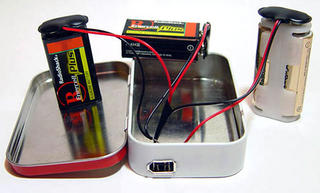Backing up your data is not the question anymore even though the latest surveys show that people are still not protecting themselves agains data loss. Well, good for them if they think they're immune. You, on the other hand, are probably looking to update your arsenal to protect your data. A few months back, I heard about rollback software and I was enthralled. Here's why I think that you should either own both rollback and backup software or, at least, have a powerful backup solution that stores your data on separate storage media.
Apparently, it's the talk of the town and has been for several months now. Rollback has hit the streets and everyone's extremely excited that the technology is helping resolve many problems.
What is Rollback Software?Rollback software is a program that allows you to "revert back" to your "original configuration or position" when some sort of "soft problem" occurs. Soft problems are any problems that relate to the operating system, software applications, configurations, preferences and settings.
Usually, Rollback software monitors data and system files as they change. For example, you may be working on an excel sheet and delete a portion of it and then committing these changes by saving the XLS. At this point if you realise that you made a mistake, you cannot recover the deleted data. Rollback software allows you to restore this deleted data by reverting back to the original file. The software also allows you to go back to earlier configurations, registry settings and entire systems. Any changes are stored on the same hard drive that contains your data.
So far, so good. Rollback software lets you replace files that you deleted accidentally (on the lowest level) and replace current problematic configurations (including registry settings) with older but more stable versions (on the highest level). This is an excellent way of restoring registry settings that may corrupt either through malware or through unwanted software installations.
Rollback software is very popular and some solutions like Norton's Go Back, are achieving rave reviews.
In my opinion, these products are of extreme importance.
However, they succeed only in resolving the soft problems. And it is these problems that are resolved with Backup Software.
What is Backup Software?Backup Software is a program that allows you to recover data and system files when soft and hard problems occur. Hard problems relate to such hardware problems as hard disk crashes and corrupt hard drives.
With backup, you select a number of files that you want to store or archive for future. This data is, in some way, important, and would typically include documents, financial data, emails, bookmarks, photos, etc.. This data is stored on a separate storage medium such as a CD, DVD or USB Pen Drive. And, it is this that makes backup more safe than Rollback software.
By saving your data in a location which is different from the original hard disk, you have the added protection against any data loss occurring from hardware failures. So if your laptop gets stolen or your hard drive fails, you have a copy to restore on to a new laptop or a new hard drive.
This is the major drawback of rollback software. Data does get lost because of hard issues such as a power surge, power drop, static electricity, magnetic forces, failing hardware component, dust, spilled coffee, etc. Rollback software does not guard you agains these problems. For example, power failures and spilled cups of coffee have destroyed more data than any viruses.
Because of certain technologies such as compression and encryption, you can compress the size of your files (to maximise storage space) and you can lock your files away from prying eyes. And these are the main advantages of backup software products over Rollback utilities. In addition, backup software allows you to set schedules when backup is performed. Recovery of lost or corrupt data or system files occurs from last backup rather from the last known "safe position". With regular backups, you will be able to pinpoint exactly when things started going wrong and restore all your data to the exact point prior to loss or error.
Backup software, however, has a major drawback - you cannot restore single registry settings. Rollback software, it is claimed, allows you to do this. Moreover, industry's response to this problem was imaging software or software that takes a complete image of your hard drive and allows you to store it separately. Although extremely effective, this software takes an image (a photograph) of your current state and restores it completely together with any viruses, corrupt files, temporary files etc.. You can't perform images very regularly (e.g., daily) as these take time and substantial storage. Imaging takes up lots of space as the files are not compressed and therefore requires large amounts of storage space especially if you have a 20Gb hard drive full of music, DVDs, images and documents.
Many backup products are bridging this gap and have imaging features while image software utilities have backup applications. Soon we will probably see a marriage of the two.
Yet, one major problem persists - that of restoring individual registry settings.
The Next Generation of Backup SoftwareA handful of backup applications, like, allow you to backup and restore single registry files of all your applications and your operating system. This means that if you make a mistake you can simply restore from your last safe position. This is exactly like rollback software with the advantage of having protection when your hardware fails since these backup applications will allow you to place these important system files separate from your hard drive.
Rollback software is file-centric, i.e., it focuses on changes in file sizes etc. This does not give you adequate protection for emails. Yes, you can backup your single mailbox database file but this does not allow you to restore single individual emails. This is a second major drawback of rollback software (and all file-centric backup).
Backup v. Rollback SoftwareSo, what's the verdict? Which should you choose, backup or rollback utilities? In an ideal world you should have both and the future will probably see backup (and rollback) software companies having features of both. However, buying both can cost you about $100 and, although it's not much when you think about how much it has cost you to build your data, not many are ready to spend so much.
In this case, I would stick to backup software simply because rollback doesn't give you protection when your hardware fails and it doesn't let you save those single emails. What do you think?



